Apollo 15
Day 13, part 1: Approaching Earth
Corrected Transcript and Commentary Copyright © 2000-2023 by W. David Woods and Frank O'Brien. All rights reserved.
Last updated 2023-12-09
286:30:15 [Music: Hawaiian War Chant by Al Kealoha Perry.]
286:32:26 Allen: Su Sois, good Endeavour crew. Su Sois. Rise and shine. It's splashdown day.
286:32:35 Scott: Oh, my, yes!
286:32:43 Allen: Good morning, Dave.
286:32:46 Scott: Good morning, Joe. That got everybody up.
286:32:55 Worden: Morning, J.P.
286:32:57 Allen: Morning, Alfredo.
286:33:03 Irwin: Joe, sounds like you're really in harmony this morning.
286:33:08 Allen: That's one.
This is Apollo Control. Apparently the crew of Apollo 15 is very definitely awake after having the Hawaiian War chant come up the air waves. The heart rates on the cardioscope here jumped somewhat on the Flight Surgeon's console as the music began. That particular version of Hawaiian War Chant done by Al Kealoha Perry. Apollo 15 now 53,782 feet - as you were - miles - nautical miles [99,604 km] from Earth, approaching at a velocity of 7,940 feet per second [2,420 m/s]. 8 hours, 35 minutes till splashdown.
286:39:03 Scott: Okay, Houston; Endeavour. We got a postsleep checklist for you.
286:39:13 Allen: Okay, Dave. Go ahead.
286:39:17 Scott: Okay. Okay. About 8 hours apiece on the sleep, and ready for your consumables.
286:39:26 Allen: Roger. At 286 plus 30; RCS total, 36 percent; quad A, 41; [B], 36; [C], 30; [D] 37. H
2 tank, 27, 24 and 29 [hydrogen tanks 1, 2 and 3, respectively]; O
2 tank, 43, 44 and 37 [again, tanks 1, 2 and 3]. I've got the world's smallest list of updates for your Flight Plan, and I've got the news summary when you're ready.
286:40:07 Scott: Okay. Give us a couple of minutes on those. Thank you.
286:51:46 Scott: Houston, Endeavour.
286:51:52 Allen: Go ahead.
286:51:57 Scott: Well, we just got our first view of the Earth this morning, and, can you believe it's getting larger and it's getting smaller? We see just a very, very thin sliver of a very large round ball.
286:52:20 Allen: Roger, Dave. I believe that.
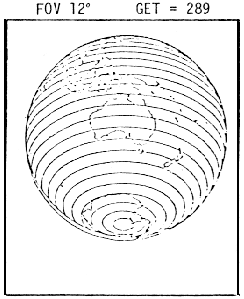
Diagram of the Earth from the spacecraft at 289 hours GET.
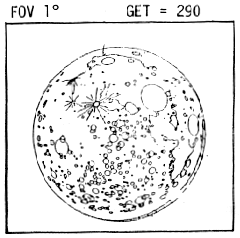
Diagram of the Moon from the spacecraft at 290 hours GET.
286:52:31 Scott: And, go ahead with the updates, Joe.
286:52:44 Allen: Roger, Dave. These are the Flight Plan updates for today. And - would you believe - I don't have any DAP load changes to give you, which is fortunate. The first addition is at 288 plus 18. And it reads "X-ray to Off, Alpha Particle to Off."
286:53:24 Scott: Okay, 288:18, X-ray, Off and Alpha, Off. Go.
286:53:29 Allen: Roger. And all the rest are just reminders, really. The first one at - on - at 290, on the UV photo's page, you've already changed the two frames line to read one frame at 20 seconds and the second frame at 2 seconds. A reminder to use mag Papa instead of mag Metro. And, finally, we'd like to remind you to enable all jets before beginning the maneuvers today. And we're - we're thinking now we'll likely do a midcourse 7 correction of about - probably around 5 feet per second [1.5 m/s]. Over.
286:54:24 Scott: Okay. I got the UV on the change, and the mag Papa on; and enable all jets prior to maneuvers; and you're looking at midcourse 7 at 5 [feet per second, about 1.5 m/s]. That's very interesting.
286:54:36 Allen: It's also not certain, but we'll keep you posted on that. And that's all the official updates I have for you. I have a news summary, if you'd like to listen.
286:54:46 Scott: Okay. Everybody's [has their headsets plugged] in...; go ahead.
286:54:51 Allen: Roger. And this will be a short one. The rest of it, you can read for yourselves today in the papers. Congress has started a month-long summer recess, setting the pattern for a government-wide exodus likely to make Washington a virtual ghost town for the rest of August. The Senate finally quit at 7:30 Friday night, more than six hours after the House had adjourned at about one in the afternoon. And after passing an 18 billion dollar higher education bill and three key appropriations measures. Besides the Labor-HEW appropriations, the Senate approved, Friday, a $1 billion measure to provide public service jobs mainly for Vietnam veterans and a continuing resolution to fund agencies still without regular appropriations until the 15th of October. In Chile, four [sic] government ministers presented their resignations to president Salvador Allende on Friday, causing the first cabinet crisis since the President took office last November. I have a long list of baseball scores which I think I'll skip over here. In exhibition football, the Buffalo Bills downed the New Orleans Saints, 14 to 10, and the Cowboys won over the L.A. Rams, 45 to 21. In the American Golf Classic at the Firestone Country Club in Akron, Ohio, Jerry Heard is still leading with 7 under par, 133, at the halfway mark. And Bob Lunn is next with a 4 under par, 136. The United States basketball team was eliminated yesterday in the Pan-American games in Columbia, and the U.S. baseball team was upset by the Dominican Republic, 5 to 4. In tennis, Stan Smith is the last seeded player still in competition at the Western Championship in Cincinnati. And today in Chestnut Hill, Massachusetts, Marty Riessen meets Australian Ken Rosewall, and South African Cliff Drysdale meets John Newcombe in the semi-finals of the U.S. professional tennis tournament. And that's all I have from here. Over.
286:58:20 Scott: Okay. Thank you, Joe. That's interesting.
286:58:24 Scott: Hey, Houston, 15. By the way, where did the 5 feet per second come from? Should we get our trusty navigator up there to navigate some more for you?
286:58:39 Allen: Dave, it probably came for - from the uncoupled - thrusting we were doing yesterday. Other than that, I'm not really sure. It's - it's by no means certain. Anyway we're just, I guess - we'll be watching it today and get back with you, with the final bit of information on it.
286:59:01 Scott: Okay. Very good. Just thought maybe we'd get our navigator to navigate again, and it would probably go away, as most of them have done so far.
287:00:13 Allen: Endeavour, the Saturday morning weather report of the landing area reads, "High scattered, 2,000 scattered, 15-knot winds out of the east-northeast, 10 miles vis[ibility], and waves going to 4 feet." It should be well above your personal minimum.
287:00:35 Scott: Looks very good. We appreciate that.
287:00:46 Scott: Sounds like the recovery troops have things in hand as usual.
287:00:51 Allen: Yes, indeed.
287:32:05 Allen: Endeavour, this is Houston. Requesting Gamma-ray, Gain Step, switch to center, please.
287:32:13 Scott: Roger. Gamma-ray, Gain Step to center.
287:33:19 Allen: And, Endeavour, this is Houston. SIC over and out.
287:33:29 Scott: Hey, Mr. SIC! Congratulations on a super job all the way. Sure appreciate it.
287:33:40 Allen: Roger, Dave. Likewise in every way. See you at Ellington [Air Force Base in Houston].
287:33:45 Scott: Okay, very good.
287:55:26 Irwin: Houston, this is 15. [No answer.]
287:55:54 Irwin: Houston, this is 15 with the PRDs - readings.
287:55:59 Parker: Roger, 15. Go ahead.
287:56:03 Irwin: Good morning, Bob. Okay, for Al, it's 25034 and mine is 08041.
287:56:12 Parker: Roger. You got one for Dave?
287:56:16 Irwin: Okay. His is not working any longer.
This is Apollo Control at 288 hours, 5 minutes. Apollo 15 is 46,778 nautical miles [86,633 km] from Earth. Velocity: 8,622 feet per second [2,628 m/s]. We're 7 hours, 5 minutes from landing. Apollo 15 will perform the midcourse correction number 7. Looking right now at time very close to the Flight Plan. Midcourse [7 will occur] somewhere around 291 hours, 56 minutes. And it will be on the order of 5 feet per second [1.5 m/s]. We will use the Reaction Control System attitude thrusters on the Service Module for this midcourse. We will get some more tracking before we firm up the burn and the time. Tracking during the sleep period last night, while the spacecraft was in a stable trajectory, shows that the trajectory was perturbed somewhat during the maneuvering yesterday while the crew was performing some of the experiments and photography work. So a midcourse will be required. At 288 hours, 7 minutes, this is Mission Control, Houston.
This is Apollo Control at 288 hours, 22 minutes. The SIM bay experiments have been completed for this Mission. Flight Director Gene Kranz logged the time at 288 hours 17 minutes when the SIM bay was secured for the final time.
This is Apollo Control at 288 hours, 27 minutes. Apollo 15 has ended Passive Thermal Control rotation now. The crew will shortly be realigning the inertial platform and then will go through a series of cislunar navigation star sightings.
288:33:08 Parker: Apollo 15, Houston.
288:33:12 Irwin: Go ahead, Bob.
288:33:13 Parker: Roger. Correction of the Flight Plan. We'd like to have all crewmembers on the biomed harness for entry. I suspect that means Dave won't be doffing his about now.
288:33:34 Irwin: Okay, I guess we could give you two. The - our trusty CMP has his off and stowed for entry.
288:33:44 Parker: Roger. Copy. [Long pause.]
288:34:12 Parker: Okay, 15. Looks like the surgeons can live with that without too much trouble.
288:37:49 Parker: Apollo 15, Houston. Over.
288:37:54 Irwin: Go ahead, Houston.
288:37:56 Parker: Okay. If you guys have a moment or two, we have some Flight Plan updates concerning entry - entry cue cards and Entry Checklist. Over.
288:38:08 Irwin: Stand by.
288:41:19 Irwin: Well, Bob, it'll be about a half an hour before we're ready to talk about those changes.
288:41:24 Parker: Okay, Jim. Give me a call when you're ready.
288:46:34 Worden: Houston, 15, I have some valve temps for you.
288:46:38 Parker: Roger, 15. We're ready to copy.
288:46:42 Worden: Okay. 5-C is 4.5; 5-D is 4.4; 6-A, 4.4; 4.4; 4.6; and 4.5.
288:46:57 Parker: Roger; copy.
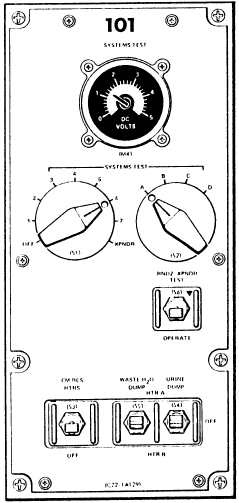
Panel 101 - the system test meter.
288:48:21 Parker: Apollo 15, Houston, Be advised, we are looking, at the present time, at a midcourse 7 burn of 5.6 feet per second [1.7 m/s] retrograde. Over.
288:48:34 Irwin: Okay. We copy.
This is Apollo Control at 288 hours, 55 minutes. Apollo 15 now 42,587 nautical miles [78,871 km] from Earth. Velocity: 9,094 feet per second [2,772 m/s]. The Retrofire Officer expects to have the final midcourse numbers ready about 289 hours, 30 minutes. We'll pass them up to the crew shortly after that. We expect the midcourse [7 burn] at about 291 hours, 56 minutes. Presently, it looks like a 5.6-feet-per-second [1.7-m/s] burn. It will be with the Reaction Control System. Burn time will be on the order of 13 seconds. We're still in the entry corridor on the - on the present trajectory without a midcourse. However, the midcourse would put us in the center of the corridor and that's where we want to be. If we entered on the present trajectory without a midcourse, we would probably land about 60 [nautical] miles [110 km] short of the landing point.
288:58:05 Parker: 15, Houston. We have your torquing angles.
288:58:10 Scott: Roger; thank you.
This is Apollo Control at 289 hours. Apollo 15 is maneuvering now to the proper attitude for the cislunar navigation star sightings.
289:01:31 Parker: Apollo 15. Request Omni Charlie, please.
289:01:37 Worden: Roger. Omni Charlie.
This is Apollo Control at 289 hours, 22 minutes. Apollo 15 is 5 hours, 36 minutes from entering the Earth's atmosphere. Endeavour now 40,241 nautical miles [74,526 km] from Earth. Velocity: 9,386 feet per second [2,861 m/s]. And it's 2 hours, 33 minutes to the midcourse burn.
289:32:04 Scott: Houston, Apollo 15. We're ready for your entry updates now if you like.
289:32:11 Parker: Roger, 15. Understand you're ready for the update. Tell Al that was another super set of marks, certainly.
289:32:17 Scott: Yes, that one came out pretty fair, didn't it?
289:32:24 Parker: Okay, 15. The first change is in the Entry Checklist, second page; and, on
page 1-2, we wish to delete step 21, which is the "DSKY Condition Light Test."
289:32:46 Scott: Okay. Step 21 deleted.
289:32:48 Parker: You may remember that one from the sim[mulator]; that's the one with the - gives us the P35 and turns the PIPAs off momentarily.
289:32:55 Scott: Yeah, I guess we don't want to do that today. [Garble]...
289:32:57 Parker: That's - that's a Rog. Okay, the next one, Dave, is on page 6, when we're checking the circuit breaker configuration on panel 8; and we're going to add "SPS Pilot Valve A, Main A and B, Main B, Open. Verify." Over.
289:33:29 Scott: Okay. SPS Pilot Valves Main A and B, both Open, and - Configuration of the circuit breakers on panel 8. Go ahead.
289:33:36 Parker: Okay. Then if we go down to the entry cue card, down to the P67 section.
289:33:44 Scott: Okay. Go.
289:33:45 Parker: Okay. Down there near the middle where it says "Steering commands downrange error minus 6 to 0," that should be changed to "Downrange error minus 24 to 0." Over.
289:34:01 Scott: Rog. Just like it is in the checklist. Right? And I think we noticed that last night looking it over.
289:34:06 Parker: Okay. And next, on the second line under the Noun 68, there's a comment that says "negative [if plus: EMS]." And there's a certain amount of happiness with that statement down here. They say that you can have a positive H dot in P67 nominally and, therefore, the statement on the cue card that this is a fail indication is not a good idea. I understand [Apollo 15 backup CMP] Vance [Brand] discuss[ed] this with Al beforehand.
289:34:39 Scott: Okay. We'll scratch that. I don't think we'll get to a P66 - 67 turnover anyway, but we'll scratch that one out. Thank you, Bob.
289:34:48 Parker: Roger. We hope not. And we have a question here, Dave, that we need an answer for, apparently concerning stowage. People are concerned about the hooks on the back of the R-12, the Flight Data File container, which is now stowed in one of the PGA bags. And they are concerned that those hooks be placed in such a way that they will not be in any danger of piercing the aft bulkhead - the pressure bulkhead. So I guess you can tell how they're placed or what's underneath them to prevent such occurrences.
289:35:22 Scott: Okay. We'll make sure of that. And I guess the problem with R-12 was that, once we got all the LM data onboard, we didn't have any place to put it, or else we didn't have any place to put the LM data. And if you have any better suggestions on where to put them, we'll be glad to do it.
289:35:39 Parker: I don't think we have any, right now, Dave. I guess the quickest thing would have been to just put it in the PGA bag with the hooks pointing up.
289:35:48 Scott: Okay. We'll do that.
289:35:50 Parker: And one reminder, Dave. You guys undoubtedly know it. Just a reminder that you will not have any back lighting for the scroll and no lighting on the roll bug today.
289:36:03 Scott: Okay. No back lighting for the scroll and no lighting on the roll bug. Thank you. [Long pause.]
289:36:28 Scott: Have anything else, Bob?
289:36:30 Parker: No, Dave. That's all I have for the moment.
289:36:33 Scott: Okay. That's pretty easy.
289:38:18 Irwin: Houston, we're standing by for a VHF comm check.
289:38:23 Parker: Stand by, Jim. We'll see if they're ready. [Long pause.]
289:38:46 Parker: 15, Houston. We'll have to stand by for another few hours to get you close enough to do that VHF comm check.
289:38:54 Irwin: All right. Roger. We understand. [Long pause.]
289:39:53 Parker: Apollo 15, Houston.
289:39:57 Irwin: Houston, 15. Go.
289:39:59 Parker: Roger. Could we have a reading of the - an onboard reading of the potable tank quantity, please?
289:40:09 Irwin: 82 per cent.
289:40:11 Parker: Copy; 82 per cent.
289:42:07 Parker: Apollo 15, Houston. Over.
289:42:11 Scott: Houston, 15. Go.
289:42:13 Parker: Roger. Could you guys check the Potable Tank Inlet valve again for us, and find out whether it is in the closed or open position? Once again, what we're seeing is the waste tank increase and the potable tank has been staying constant all morning.
289:42:30 Scott: Okay; last night when you called, I even went down and recycled that valve and made sure it was in the detent in the Open position, which it was.
289:42:38 Parker: Okay. In that case, could you go down and cycle it from closed to open again for us, please?
289:42:45 Scott: Roger. We're doing that right now. [Long pause.]
289:43:08 Scott: Okay, it was still open, and Al cycled it from open to closed and back to open.
289:43:15 Parker: Okay. Thank you. It's no big deal, Dave, nothing to worry about.
289:43:20 Scott: Might as well get everything all trimmed up.
289:43:22 Parker: That's what we're trying to do.
This is Apollo Control at 289 hours, 49 minutes. Apollo 15 is 37,858 nautical miles [70,113 km] from Earth. Velocity: 9,709 feet per second [2,959 m/s]. The crew will be taking some ultraviolet photography of the Earth in a short time. This will complete their science tasks for the mission. We'll then do the midcourse burn. [We're] 2 hours, 6½ minutes away from that burn. They will perform some more star sightings after the burn and then the rest of the time will be devoted to their pre-entry checklist. Recovery Carrier Okinawa is reported on the station. Weather in the recovery area is good. Visibility, 12 miles; waves about 3 feet.
290:00:24 Parker: Apollo 15, Houston. Requesting Omni Delta.
290:00:28 Worden: Omni Delta.
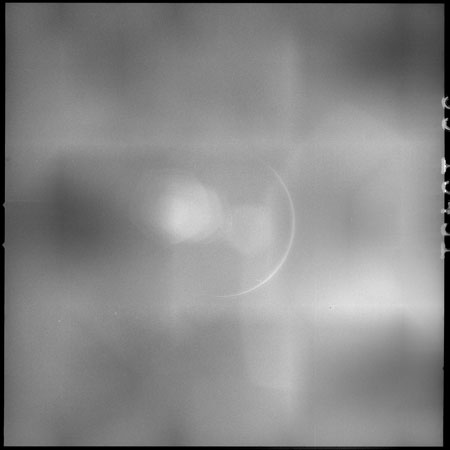
AS15-99-13491 - Ultraviolet photograph of Earth taken through filter 1. Image is contrast stretched.
Image without contrast stretching - Image by NASA/JSC/Arizona State University.
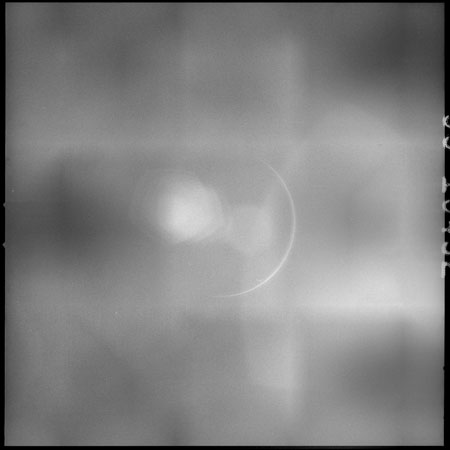
AS15-99-13492 - Ultraviolet photograph of Earth taken through filter 1. Image is contrast stretched.
Image without contrast stretching - Image by NASA/JSC/Arizona State University.
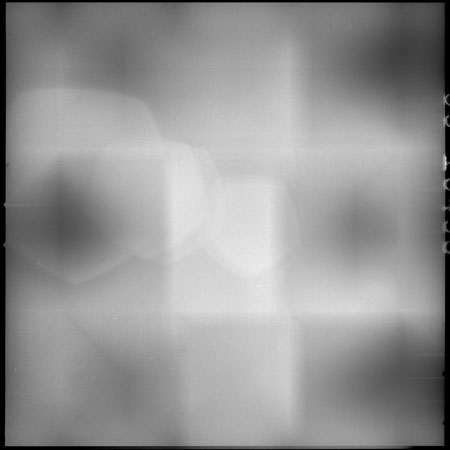
AS15-99-13493 - Ultraviolet photograph of Earth taken through filter 2. Image is contrast stretched.
Image without contrast stretching - Image by NASA/JSC/Arizona State University.
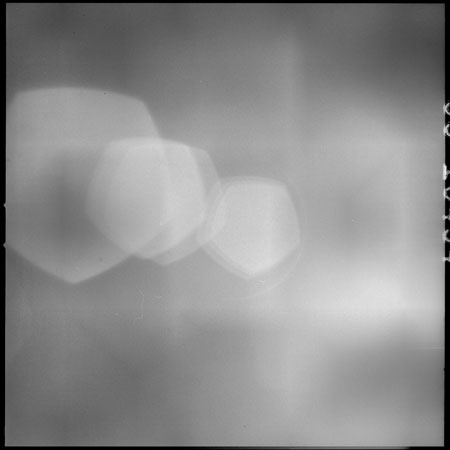
AS15-99-13494 - Ultraviolet photograph of Earth taken through filter 2. Image is contrast stretched.
Image without contrast stretching - Image by NASA/JSC/Arizona State University.
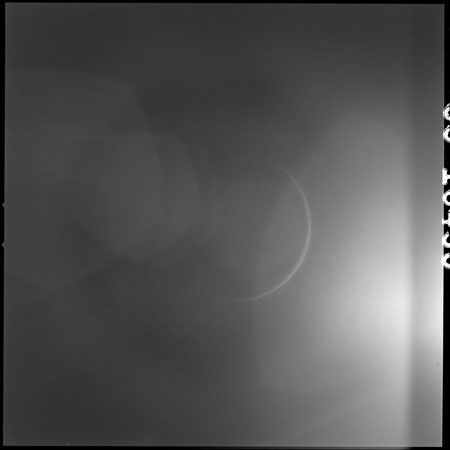
AS15-99-13495 - Ultraviolet photograph of Earth taken through filter 3. Image is contrast stretched.
Image without contrast stretching - Image by NASA/JSC/Arizona State University.
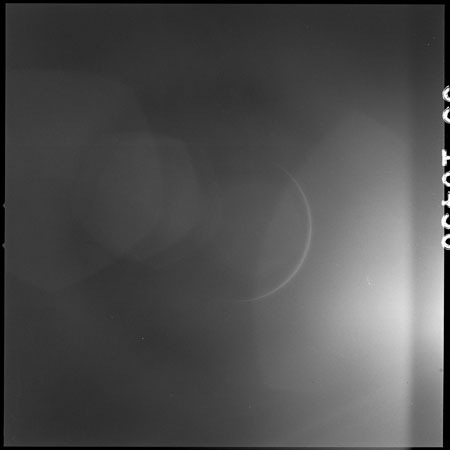
AS15-99-13496 - Ultraviolet photograph of Earth taken through filter 3. Image is contrast stretched.
Image without contrast stretching - Image by NASA/JSC/Arizona State University.
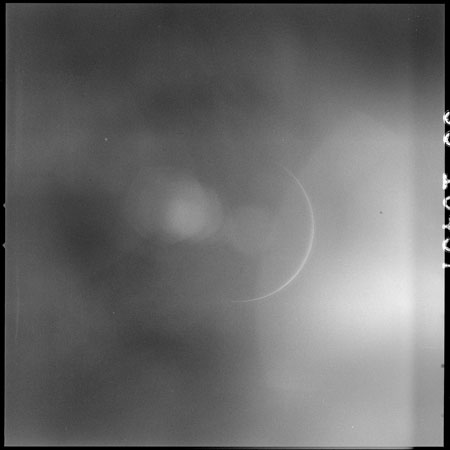
AS15-99-13497 - Ultraviolet photograph of Earth taken through filter 4. Image is contrast stretched.
Image without contrast stretching - Image by NASA/JSC/Arizona State University.
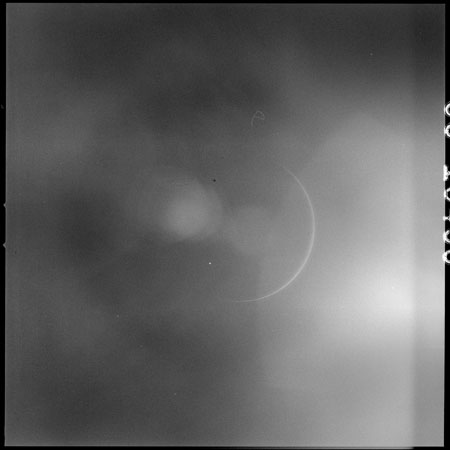
AS15-99-13498 - Ultraviolet photograph of Earth taken through filter 4. Image is contrast stretched.
Image without contrast stretching - Image by NASA/JSC/Arizona State University.
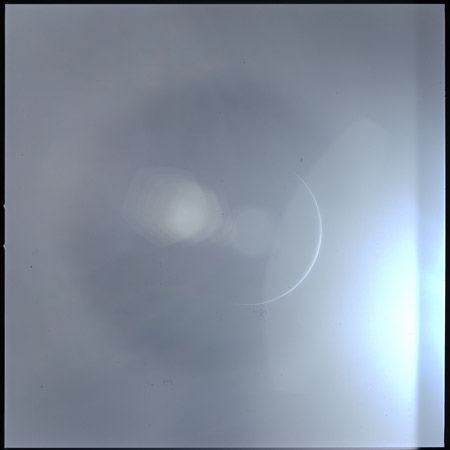
AS15-96-13136 - Comparison image of Earth on colour film - Image by NASA/Johnson Space Center.
290:08:21 Parker: Apollo 15. Requesting Omni Charlie.
290:08:24 Worden: Omni Charlie.
This is Apollo Control at 290 hours, 8 minutes. Apollo 15 has completed the ultraviolet photography of the Earth and is new maneuvering to an attitude to take some Moon photographs.
290:15:10 Parker: 15, Houston. If you'll give us [the] High Gain [Antenna] and Pitch of plus 7, Yaw of 250, then we'll be able to keep High Gain for the next 2 or 3 hours, and I won't have to keep calling you for Omnis. Over.
290:15:23 Irwin: Okay; understand, plus 7 and 250 on the High Gain.
290:25:30 Parker: 15, Houston, We're noticing some drift in roll. If you're not through with the UV photos, we'd like you to retrim back to attitude, please.
290:25:39 Worden: Okay, and we are finished with the UV photos.
290:25:42 Parker: Okay; that takes care of that one.
290:27:37 Parker: Apollo 15, Houston. Over.
290:27:41 Scott: Go ahead, Bob.
290:27:42 Parker: Okay; if you guys got a minute, we can do a few things here. Number 1, if you give us Accept, we'll send you some state vector and target loads; and, number 2, we have a couple comments to read to you.
290:27:58 Scott: Okay; you have Accept, and stand by.
290:28:01 Parker: Roger; you're getting the uplink, and we're standing by.
290:31:54 Parker: 15, the computer's yours. You have state [vector], target and REFSMMAT.
290:32:01 Scott: Roger. Thank you.
290:32:13 Scott: And, Houston, we're all on. You can go with your comments.
290:32:17 Parker: Okay; first one, news concerning the water business. We've been having you check that valve. It looks to us now as though there's a blockage into the potable tank. You got obviously - a - far more water than you need to survive the rest of the mission, but it does mean that the waste tank will be filling up, and there is a possibility that it will start to vent about an hour or two before EI [Entry Interface]. It's been discussed down here and decided that the best way to do this is - far as not perturbing the vector too much - is to let it relieve overboard and not to do a dump ahead of time or turn the water boiler on ahead of time. In line with this, we might just verify that the Pressure Relief valves down on panel 352 - the water control panel, is in the Relief position. It certainly should be there; it's just a - a little verification to make sure we're - we're not going wrong there. Second, I...
290:33:11 Scott: Okay, that's verified.
290:33:12 Parker: Okay; thank you. Second item is, we suggest that it might be reasonable to put some tape over the SPS light on the EMS to keep you from confusing with the .05g light, in case you have a problem there, Al. That's your option, obviously. It just a suggestion.
290:33:32 Scott: Oh, I don't think he'll have any confusion with that.
290:33:36 Scott: We'll make sure we watch it.
290:33:38 Parker: And the third question is, from your comments when we were talking about R-12, some people believe you may be asking us a question that you have a problem with stowage of some of the extra LM data file, or have you found a place for that already?
290:33:53 Scott: Oh, no; that's all tucked away in R-3 very - very neatly. We have no - no problem at all in the stowage. We just wanted to locate R-12 in a nice soft spot and secure it down, which it is.
290:34:04 Parker: Okay. We - we were - [ready to] crank up building 45 to find you a location if you needed it. [Pause.]
290:34:20 Parker: And, 15; Houston. We've got an entry PAD and a midcourse 7 PAD if you're ready to copy.
290:34:28 Scott: Stand by one, Bob. Let our pad leader get out his pencil. [Long pause.]
290:35:00 Irwin: Okay, Bob. I'm ready for midcourse 7.
290:35:02 Parker: Okay. Purpose, midcourse 7. RCS/G&N; 26363; Noun 48's are NA and NA; 291:56:47.90; minus 0005.6; minus all balls, plus 0000.2; roll, 180, 311, 000; H
A, NA; H
P, plus 0022.3; 0005.6, 0:24, 0005.6; 31, 347.9, 35.3. The rest of the PAD is NA. GDC align stars are Vega and Deneb; roll, pitch, and yaw for the alignment are 100, 137, 316. Burn recommendation is 2 jets, plus-X, quads Bravo and Delta. And the H
P in the PAD on Noun 44 there is based on a MSFN trajectory after midcourse 7. Over.
290:37:17 Irwin: Okay. The readback for the midcourse. It's RCS/G&N; 26363; NA, NA; 291:56:47.90; minus 0005.6, minus all zeros, plus 0000.2; 180, 311, 000; NA, plus 0022.3; 0005.6, 0:24, 0005.6; 31, 347.9, 35.3; Vega and Deneb; 100, 137, 316. Recommendation for the burn configuration, two jet, plus-X, quads Baker and Dog; and the H
P of the PAD is based on MSFN trajectory after midcourse 7.
290:38:12 Parker: Roger. Good readback, Jim; and I'll give you entry when you're ready.
290:38:18 Irwin: Okay. Stand by. [Long pause.]
290:38:34 Irwin: Okay. I'm ready for entry, Bob.
290:38:36 Parker: Okay. Entry, area, mid-Pac; 000, 153, 000; 294:41:55, 267; plus 26.13, minus 158.13; 06.1; 36096, 6.49; 1082.4, 36178; 294:58:55; 00:28; Noun 69s are NA; 4.00, 02:13; 00:18, 03:37, 07:42; 04, 140.3, 37.5; 213, down 09.5, right 4.7; lift vector, up. Comments: 1, use non-exit EMS pattern; 2, RET for 90K, 6 plus 04; 3, RET for mains, 8 plus 30; 4, RET for landing, 13 plus 27; 5, constant g, roll right; 6, moonset, 294:56:37. Over.
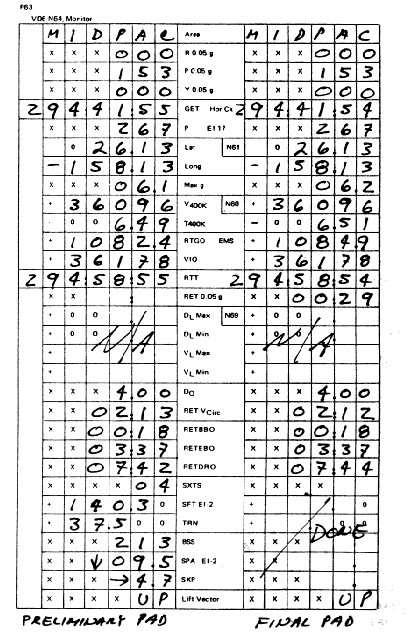
The form for copying down the entry PAD.
290:39:15 Irwin: Okay, Bob. Readback for the entry PAD. It's mid-Pac, 000, 153, 000; 294:41:55, 267; plus 26.13, minus 158.13; 06.1; 36096, 6.49; 1082.4, 36178; 294:58:55; 00:28; Noun 69 is NA; 4.00, 02:13; 00:18, 03:37, 07:42; 04, 140.3, 37.5; 213, down 09.5, right 4.7; up. Comments: Use non-exit EMS pattern; RET for 90K, 6 plus 04; for mains, 8 plus 30; landing, 13 plus 27; constant g, roll right; moonset, 294 plus 56 plus 37. Over.
290:42:37 Parker: Roger. Good readback, Jim. [Long pause.]
290:43:12 Parker: And, 15, we'd like Accept again. It looks like we found some errors in the load that we sent up.
290:43:20 Irwin: Okay; stand by. [Pause.]
290:43:25 Irwin: Okay; you have Accept.
290:43:27 Parker: Thank you.
290:43:44 Irwin: Houston, 15. Picked off the Verb keys zero - on top of you. Sorry about that. It's all yours.
290:43:50 Parker: Okay. [Long pause.]
290:44:11 Parker: 15, we'll clear it. Don't worry.
290:48:50 Parker: 15, Houston. The computer's yours again.
290:48:57 Irwin: Roger, Bob. [Long pause.]
290:49:49 Parker: Apollo 15, Houston. We would like the VHF turned on even though it's too early to do the comm check. [We would] like it turned on in Simplex Alpha to warm it up, and so we can watch it.
290:50:12 Irwin: Okay, we're turning on Simplex Alpha.
290:50:39 Parker: Thank you, 15.
This is Apollo Control at 290 hours, 54 minutes. Apollo 15 now 31,707 nautical miles [58,721 km] from Earth. Velocity: 10,674 feet per second [3,253 m/s]. We're an hour and 2 minutes away from the midcourse burn that will be performed at 291 hours, 56 minutes, 47 seconds; Delta-V of 5.6 feet per second [1.7 m/s]. We'll use 2 jets and the duration of the burn will be 24 seconds. Based on a successful midcourse 7, the elapsed time for Entry Interface with the atmosphere at 400,000 feet - will be 294 hours, 58 minutes, 55 seconds. Spacecraft velocity at that time, 36,096 feet per second [11,002 m/s]. And the 'range to go' to the landing point, 1,082.4 nautical miles [2,004.6 km]. The elapsed times of entry events from the Entry Interface time - we'll begin blackout 18 seconds after Entry Interface. Blackout will end 3 minutes, 37 seconds; drogue chutes, 7 minutes, 42 seconds; main chutes, 8 minutes, 30 seconds; and landing, 13 minutes, 27 seconds. The coordinates of the aim point for landing: 158 degrees, 8 minutes west; 26 degrees, 8 minutes north.
291:00:33 Parker: And, 15, we have your torquing angles.

Diagram showing the orientation of the Entry REFSMMAT.
291:03:47 Scott: Houston, 12. [Do] you have the torquing angles?
291:03:53 Parker: Roger, 12. We have the torquing angles.
291:03:56 Scott: Okay. That's through.
This is Apollo Control at 291 hours and 11 minutes. Apollo 15 is maneuvering now to the midcourse burn attitude. That burn is scheduled in 45 minutes.
This Apollo Control at 291 hours, 29 minutes. We're 27 minutes away from the midcourse burn. And Apollo 15 is 28,159 nautical miles [52,150 km] from Earth. Velocity: 11,347 feet per second [3,459 m/s]. In the next 3 and a half hours, at which time Apollo 15 will enter the atmosphere, that velocity will build to 36,000 feet per second [11,000 m/s].
291:40:02 Parker: Apollo 15, request Omni Alpha, please.
This is Apollo Control at 291 hours, 46 minutes. We're 10 minutes away from the midcourse burn now. Distance: 26,285 nautical miles [48,152 km] from Earth. Velocity: 11,743 feet per second [3,579 m/s].
291:51:50 Parker: 15, at 5 minutes to go, you're looking good.
291:51:55 Scott: Roger. Thank you. We're all set.
291:54:46 Parker: 15, Houston. Requesting Key Release and Enter to complete the integration and get us down for the burn.
291:55:04 Scott: Houston, the integration should all be done.
291:55:08 Parker: Rog. Somebody on the ground here hasn't seen it, apparently,
291:55:12 Scott: Okay, we've been sitting here for about 5, 6 minutes.
291:55:17 Parker: Rog. We couldn't tell. Sorry about that, Dave.
1 minute.
291:56:22 Scott (onboard): ...Normal.
291:56:23 Irwin (onboard): Tape Recorder's on High Bit Rate. Record the start.
291:56:29 Scott (onboard): Okay. It worked.
291:56:32 Worden (onboard): Yes.
291:57:04 Worden (onboard): 10, 9, 8, 7, 6, 5, 4, 3, 2, 1...
291:57:14 Worden (onboard): Zero.
291:57:15 Irwin (onboard): [Garble] open.
Apollo 15 is thrusting. GNC says it looks like a good burn.
291:58:00 Scott: Okay, Houston; 15 with the burn status report.
291:58:02 Parker: Roger that.
291:58:04 Scott: Okay, T
IG was on time. Burn time was 21 and came right out on the money, and it clicked up a couple of seconds after the shutdown to minus .1, 0 and minus .1. Delta-V
C was plus .8.
291:58:21 Parker: Roger. Copy that, Dave. It looked good to us.
292:00:07 Parker: 15, Omni Bravo, please.
292:00:12 Scott: Roger. Omni Bravo.
This is Apollo Control at 292 hours, 1 minute. Telemetry shows Apollo 15 maneuvering to the optics calibration attitude as the crew gets ready to perform some additional cislunar navigation star sightings.
292:02:31 Parker: Apollo 15, Houston. If you'll give us Accept after you get maneuvered to attitude before you go into P23 to start the optics cal, we'll uplink you your new state vector, and then you can press on with the P23s as soon as that's up.
292:02:47 Scott: Roger. [Long pause.]
292:03:01 Scott: You've got it.
292:04:17 Parker: 15, Houston. The computer's yours.
292:08:27 Parker: And, 15, requesting Omni Charlie.
292:08:31 Scott: Roger. Omni Charlie.
This is Apollo Control, at 292 hours, 11 minutes. Apollo 15 is 2 hours, 47 minutes away from the Earth's atmosphere, 3 hours away from landing in the Pacific Ocean, about 285 nautical miles [528 km] north of Oahu, Hawaii. Endeavour's distance from Earth now is 23,494 nautical miles [43,511 km]. Velocity has built to 12,410 feet per second [3,783 m/s].
This is Apollo Control. The Command Module/Service Module separation time listed in the Flight Plan is valid. 294 hours, 43 minutes.
This is Apollo Control at 292 hours, 21 minutes. The Apollo 15 backup crew has joined CapCom Bob Parker at his console. Dick Gordon, Vance Brand and Jack Schmitt.
This is Apollo Control. Flight Director Gene Kranz has now been joined by the other flight directors for this mission; Gerry Griffin, Glynn Lunney and Milton Windler. And the management officials are beginning to assemble. At the Department of Defense console is Maj. Gen. David M. Jones, the DoD manager for manned spacecraft support. Mission Director Capt. Chester Lee is here. Dr. Rocco Petrone, the Apollo Program Director, and Col. James McDivitt, the Apollo Spacecraft Program Manager.
This is Apollo Control at 292 hours, 35 minutes. Flight Dynamics reports that the tracking data accumulated so far since the midcourse burn shows that that burn did what it was designed to do. That is put Apollo 15 in the center of the re-entry corridor. They'll continue to collect data and verify that.
This is Apollo Control at 292 hours, 42 minutes, Apollo 15 now 19,927 nautical miles [36,905 km] from Earth. Velocity: 13,434 feet per second [4,095 m/s]. We're 2 hours, 16 minutes away from Entry Interface and about 2½ hours away from landing.
292:56:48 Scott: Houston, 15.
292:56:51 Parker: 15, go ahead.
292:56:53 Scott: Roger. We're ready for logic sequence check.
292:57:00 Parker: And, 15, we're ready for a logic sequence check also.
292:57:03 Scott: Okay. Sequential Logic coming on now - number 1, number 2.
292:57:19 Parker: And, 15, you're Go for Pyro Arm.
292:57:23 Scott: 15; Roger.
This is Apollo Control at 293 hours. Apollo 15 now 17,680 nautical miles [32,743 km] from Earth. Velocity: 14,190 feet per second [4,325 m/s]. Apollo 15 is 1 hour, 58 minutes away from Entry Interface. 2 hours, 11½ minutes away from landing. During entry, the prime recovery ship, the helicopter carrier USS Okinawa will be about 5 nautical miles [9 km] north of the aimed point. In the vicinity of the carrier, 2 helicopters will be airborne. Call signs, Photo and Relay. Photo helicopter will have the photographers aboard. Relay will carry backup swimmers and act as a radio relay between the carrier, and the spacecraft, and the other helicopters in the area. Swim 2 helicopter will be the prime helicopter to deploy swimmers with the floatation collar. Swim 2 will be 5 nautical miles [9 km] south of the aimed point at entry. Swim 1 will be the backup for Swim 2 and the Swim 1 swimmers will be deployed to recover the parachutes. Swim 1's location during entry, 10 nautical miles [19 km] west and 15 nautical miles [28 km] north of the aim point. The recovery helicopter, the helicopter which will recover the crew will be 10 nautical miles [19 km] east and 15 nautical miles [28 km] north of the aimed point at entry.
The recovery helicopter will be piloted by Commander Stephen A. Coakley of Chula Vista, California. His co-pilot, Lieutenant Junior-Grade John M. Murphy, Jr., of La Jolla, California. Crewmen are Aviation Machinist Mate, First Class, Ernest L. Skeen of Oklahoma City, and Aviation Electronic Technician, Second Class, Thomas R. Hardenbergh of East Lansing, Michigan. A Manned Spacecraft Center Flight Surgeon, Dr. Clarence A. Jernigan of Dickinson, Texas will also be aboard Recovery helicopter. Swim 2, the prime flotation collar helicopter, is piloted by Lieutenant Commander, David D. Cameron, Jr., of Palo Alto, California; co-pilot, Lieutenant Junior Grade Stephen M. Lind of Olympia, Washington, crewman Aviation Machinist Mate, Second Class, John H. Driscoll of Whitehouse Station, New Jersey, and Aviation Electronics Technician, Third Class, Bryce E. Devenport, of Glenns Ferry, Idaho. The swim team leader on that helo is Lieutenant Junior Grade, Fred W. Schmidt of Northbrook, Illinois. Swimmer Number 2, Quartermaster, First Class, William C. "Jake" Jakubowski of Lachawanna, New York. Swimmer Number 3, Yeoman, Third Class, Rudy R. Davis of Ashland, Kentucky. Swim 1 is piloted by Lieutenant Donald M. Larsen of Wellman, Iowa; co-pilot. Lieutenant Junior Grade Eric J. Challain of Olympia, Washington. Crewmen are Aviation Machinist Mate, Second Class, Larry G. Parker of Ringold, Georgia and Aviation Anti-submarine Warfare Technician Airman Thomas F. Sharafik of Hayward, Wisconsin. The swim team leader on Swim 1 is Warrant Officer Jerry L. Todd, Sturgis, Michigan, swimmer number 2 is Ship Fitter, Third Class, Frank S. Schroeder, Malvern, Pennsylvania and swimmer number 3, Radioman Seaman Roy Alan Buehler, Carrollton, Missouri.
293:07:10 Parker: Apollo 15, Houston. Over.
293:07:14 Scott: Houston, 15. Go.
293:07:16 Parker: Roger. I thought we'd let you know, from our preliminary tracking, you're sitting right in the center of the [entry] corridor now.
293:07:23 Scott: Great. That's a nice place to be.
293:07:25 Parker: The best.
This is Apollo Control at 293 hours, 19 minutes. Apollo 15 now 15,225 nautical miles [28,197 km] from Earth. Velocity: 15,173 feet per second [4,625 m/s].
This is Apollo Control. The flight crew aboard the helicopter which will provide photo coverage for recovery operations; the pilot is Lieutenant Commander John M. Quarterman of Brunswick, Georgia; the co-pilot Lieutenant Junior Grade Ronald D. Martin, Roanoke, Virginia. Crewmen are Aviation Structural Mechanic, Second Class, Douglas P. Walker of Selma, Alabama; and Aviation Machinist's Mate Airman Gregory G. Wahl of Santa Monica, California. The crew aboard the relay helicopter; pilot is Lieutenant Michael T. Boyce, Bainbridge Island, Washington; co-pilot...
293:20:50 Parker: And, 15, we copy your torquing angles.
293:20:53 Scott: Roger. Thank you.
Relay's co-pilot is Lieutenant Junior Grade Timothy D. Kelly, Long Island, New York; Crewman ADR, First Class, Raymond D. Brooks of Nampa, Idaho; and Aviation Anti-Submarine Warfare Technician Airman Ronald C. Weaver, Madcroft, Wisconsin. The backup swimmers aboard Relay: the swim leader is Lieutenant Junior Grade Jonathan Smart of Belmont, Massachusetts; swimmer number 2 is Ship Serviceman, Second Class, William Ramos-Flores of Bayamon, Puerto Rico, and swimmer number 3 is Boilerman, Third Class, Roderick T. Yonkers, Brookfield, Connecticut.
This is Apollo Control with a correction on the home state of Ronald C. Weaver, one of the crewmen on the Relay Helicopter. He is from Madcroft, Wyoming.

An intricate pattern of lines from the EMS display which define the relation between velocity and deceleration forces.
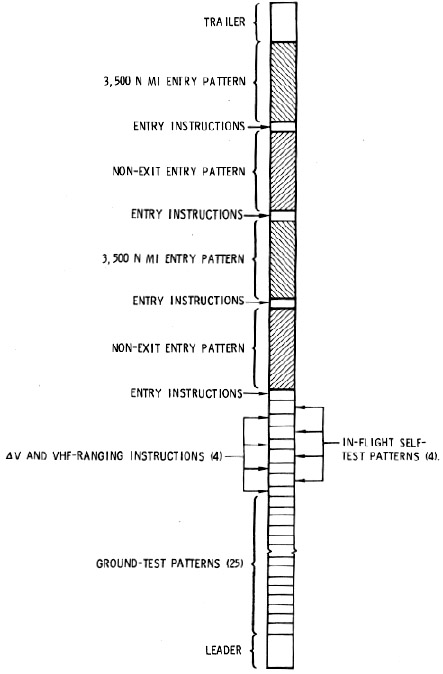
Several test patterns which are used to verify the EMS's circuits.
293:34:42 Worden: Houston, 15.
293:34:46 Parker: Roger, 15. Go ahead.
293:34:48 Worden: Okay. EMS check worked fine.
293:34:51 Parker: That sounds good.
This is Apollo Control at 293 hours, 37 minutes. Mr and Mrs James Irwin, the parents of Apollo 15's Lunar Module Pilot, have arrived in the viewing room here at the Control Center. Also, in the viewing room at this time, Dr. George M. Low, the Deputy Administrator of NASA, and Dale Myers, the Associate Administrator for Manned Space Flight. The MSC Deputy Director Christopher C. Kraft and the Director of Flight Operations Sigurd Sjoberg are in the Control Room proper at this time.
This is Apollo Control. Donald K. Slayton, the Director of Flight Crew Operations has joined CapCom Bob Parker and the Apollo 15 Backup Crew at the CapCom Console.
This is Apollo Control. Congressman William Archer and his mother, are now in the viewing room. And at 293 hours, 45 minutes; Apollo 15 is 11,611 nautical miles [21,504 km] from Earth. Velocity: 17,024 feet per second [5,189 m/s].
293:47:42 Parker: Apollo 15, Houston. If you'll give us Accept, we'll send you up a final state vector.
293:47:49 Scott: Roger, Houston. You've got it.
293:47:54 Parker: And, Roger; you're getting it.
293:49:49 Parker: And, 15, it's your computer again.








